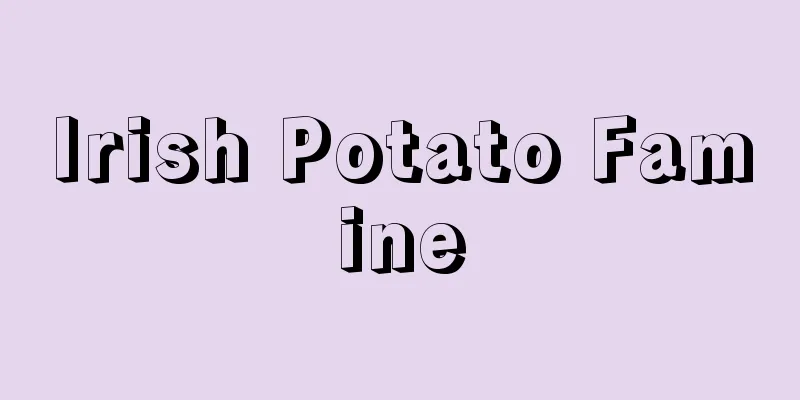Irish Potato Famine

|
A famine in Ireland from 1845 to 1849, caused by potato crop failure due to leaf blight. It was the worst famine in Europe in the 19th century. By the early 1840s, about half of the Irish population was dependent on potatoes for most of their diet. The leaf blight fungus was introduced from North America. In 1845, Ireland experienced unusually cold and humid weather, which allowed the fungus to grow and cause most of that year's harvest to rot in the fields. The next year, 1846 to 1849, saw even more severe crop failures, with almost the entire harvest lost to leaf blight. The costs of providing relief to the peasants were largely borne by Irish landowners, who quickly ran out of funds as the peasants could not pay their rent. The British, who controlled Ireland, limited their support to loans, financial assistance for canteens, and job creation through public works such as road construction. Cornmeal imported from the United States was effective in preventing starvation to some extent, but it was not to the taste of the Irish people, and the unbalanced diet caused malnutrition. The British government spent a total of about 8 million pounds on relief measures. During the famine, Irish farmers did not have the money to buy food, so they continued to export high-quality foods such as grain and meat overseas. The population of Ireland changed dramatically after the famine. It was about 8.4 million in 1844, but by 1851 it had fallen to 6.6 million. About 1 million people died from hunger, typhus, and other hunger-related diseases. An estimated 2 million Irish immigrants left for other countries during the famine. Source: Encyclopaedia Britannica Concise Encyclopedia About Encyclopaedia Britannica Concise Encyclopedia Information |
|
1845~49年アイルランドで,葉枯病によるジャガイモの不作のために起こった飢饉。19世紀にヨーロッパで発生した最悪の飢饉となった。アイルランドでは 1840年代初めには人口の約半分が食事のほとんどをジャガイモのみに頼るようになっていた。葉枯病菌が北アメリカから持ち込まれた 1845年,アイルランドは例年になく気温が低く湿度が高かったため病原菌が繁殖し,その年の収穫の大部分は畑で腐ってしまった。続く 1846~49年にはさらに深刻な不作に見舞われ,収穫のほぼすべてが葉枯病で失われた。農民を救済する費用は,もっぱらアイルランドの地主が負担したが,農民が地代を払えなかったため,地主の資金もすぐに尽きた。アイルランドを支配下に置いていたイギリスによる支援は,融資,無料食堂の運営資金援助,道路建設などの公共工事を通じた雇用創出にかぎられていた。アメリカ合衆国から輸入されたコーンミールは,餓死を防ぐ一定の効果があったものの,アイルランド人の口に合わなかったうえ,かたよった食事が栄養失調を引き起こした。イギリス政府は救済措置に総計約 800万ポンドを費やした。飢饉の間も,アイルランドの農民は食料を買う金がなかったため,穀物や肉など上質の食料を国外に輸出し続けた。この飢饉を境にアイルランドの人口は大きく変化した。1844年に約 840万人だった人口が 1851年には 660万人に減少した。飢えや発疹チフス,その他飢えによる病気により,約 100万人が死亡した。この飢饉の間に他国に渡ったアイルランド移民は,推計 200万人に上る。
出典 ブリタニカ国際大百科事典 小項目事典ブリタニカ国際大百科事典 小項目事典について 情報 |
<<: Potato tuberworm (Potato tuberworm)
Recommend
Coronula diadema
...Other known barnacles include the striped turt...
Oishi Ruins - Oishii Seki
A site from the final Jomon period in Oishi, Ogata...
Ishii Issai
…During the Edo period, they served the Kaga and ...
Cantharellus aureus (English spelling)
…[Rokuya Imaseki]. . … *Some of the terminology t...
Venture Business
This refers to small and medium-sized enterprises ...
ephedrine
α-[1-(methylamino)ethyl]benzenemethanol. C 10 H 1...
Normal distribution
The probability density is A probability distribu...
Nakhichevan' (Autonomous Republic)
An autonomous republic within the Trans-Caucasian ...
Baluze (English)
1630‐1718 French historian. Born in Tulle. Served ...
Japan Amateur Sports Association
…The governing body of amateur sports in Japan. J...
Urabenihoteishimeji - Urabenihoteishimeji
...There are edible mushrooms in the Shimeji genu...
Automatic control
Control is the act of manipulating the state or b...
Hoddis, J. van
…They placed more importance on poetry than on pr...
Sokodara - There
A marine fish belonging to the family Rattailidae...
Akikuni Kasuga
?-1344 A military commander during the Nanboku-ch...






![Gaga [Hot Spring] - Gaga](/upload/images/67cb2c48ab4f4.webp)


